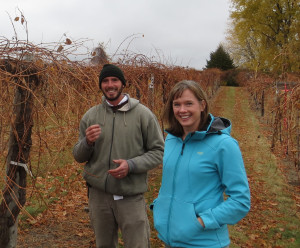La Crescent: A Winemaker’s Grape
The first time I had a glass of wine made from La Crescent, I was completely blown away.
Reminiscent of an aromatic white that might come from Germany or Austria, my mind started spinning with all the potential this grape has for winemakers in Minnesota. The high acidity makes it relatively versatile for various winemaking styles from dry to sweet or even fortified dessert wines, while the tropical fruit and floral aroma make it an easy sell to consumers.
The La Crescent grape originated from a cross between St. Pepin and ES 6-8-25, both selections from the breeding program of Elmer Swenson. It has a complex lineage in which the French hybrid ‘Seyval Blanc’ and V. vinifera ‘Muscat Hamburg’ play a role. Its aromatic profile leans towards muscat, but I’ve also encountered examples that are so fruit-forward that the aroma is reminiscent of the children’s cereal with a toucan on the label.
Surprisingly, an example I had from Iowa so resembled an herbaceous Sauvignon Blanc, that I had a hard time believing that it was a 100% varietal wine (it was fermented using a thiol-producing yeast).
There is, however, a dark side to such a seemingly perfect cold-hardy wine grape. The vine itself isn’t always pretty to look at – its procumbent growth habit making it look as though it is always weeping, and the leaves and fruit can show some disease.
It has moderate resistance to powdery mildew and black rot, but it is susceptible to downy mildew and foliar phylloxera. It’s not a vine for growers who plan to be weekend warriors, as anti-fungal sprays need to be well-timed with bud-break, bloom, and high disease situations (rainfall and humidity) throughout the spring.
The high-vigor canopy also needs to be managed throughout the growing season to allow for good air-circulation. It’s a vine that will punish growers who don’t use good practices. In addition, poor fruit set and late season berry shelling can be troublesome in certain vintages or on particular vineyard sites (though the exact cause is unknown).
The viticultural challenges of La Crescent have unfortunately caused some growers to give up on this variety entirely. I say ‘unfortunately” because even though I’ve outlined some scary prospects, these aren’t unmanageable problems. Botrytis and berry splitting are non-existent, and own-rooted vines are long-lived.
Although La Crescent is a difficult cold-hardy vine when compared to say, Frontenac, in the wide world of viticulture, it is still relatively easy to manage. It is also extremely cold-hardy — tolerating temperatures as cold as -36°F (-38°C) in early February with only minor bud loss. This characteristic, along with the quality of the fruit, means that it is definitely a grape that northern growers should not turn away. It is truly a winemaker’s grape, but one that growers shouldn’t give up on for all its difficulties.
To this day, whenever I’m introducing someone to Minnesota wines, the first wine I tend to start with is one made from La Crescent. Even though Marquette is getting lots of hype, its lack of tannins and its high relative acidity for a red grape still cause wine drinkers to find it ‘unusual” if they are accustomed to drinking Malbec or Cabernet Sauvignon.
However, La Crescent, when done well, can easily be confused for a Moscato or perhaps a Grüner-Veltiner wine. It’s floral, fruit-forward, and citrusy. Served chilled it’s a perfect wine to serve in the summertime. It also tends to be made in somewhat of an off-dry style rather than bone dry, which is an approachable style to many.
The sugar and acid levels tend to be relatively high when compared to V. vinifera grapes. Sugar levels at harvest average around 25° brix, while acid levels average about 12 g/L, thus the wine is very well-suited towards an off-dry to sweet wine. Because late-season berry shelling can be an issue, making a late-harvest or ice wine comes with risks. Nonetheless, winemakers utilizing cryo-extraction methods or drying the grapes to further concentrate the sugars have been awarded with high-quality, award winning dessert wines. I dare anyone to pick up a bottle and see if they aren’t smitten by its charms.
For more information: http://grapes.umn.edu/LaCrescent/
Katie Cook is the enology project leader at the University of Minnesota and the author of the University of Minnesota Enology Blog





Very interesting article, Katie! There are a couple wineries here in Ohio that make very nice LaCrescent wines. I do hope someone can solve the berry-shelling problem…perhaps a nutritional disorder?? Good luck on that.
I’ve found some literature stating that berry shelling in V. vinifera can be caused by high nitrogen content in the soil, so my guess is that there is a good probability that vine nutrition plays a role.
Great article but it just keeps me guessing. I’m thinking about adding an acre of white next year and was going to plant it in Lacresent but I’m on the fence. I would like to hear from people making wine, what do you like to work with (cold hardy) to make a dry white and semi dry. I would also like to hear from the people growing Lacresent if you could would you replace and if so with what? Thanks
Jeremy – I don’t think there’s really a cold-hardy substitute for LaCrescent; its flavor profile is just hard to match with anything else. Frontenac Gris or Blanc come to mind as being quite cold hardy, but flavors are quite different from LaCrescent. Katie mentioned that the berry shelling problem might be related to excessive nitrogen, but I wonder about that….the worst shelling problem I have encountered with LaCrescent was in a vineyard whose soil is almost pure sand….unlikely to be very high in nitrogen. Just a thought…
Just to clarify, I am making no statements regarding the source of the shelling problem. I only mentioned nitrogen because there is some literature supporting it in V. vinifera. When I made the statement earlier, I was only supporting your theory that it could be a vine nutrition issue. It may have nothing to do with nitrogen.
Good clarification, Katie. I obviously misread your first statement. Best of luck to anyone who is researching the shelling problem; the wine quality of this variety is just too good.
Just a few points on LaCrescent. First, I agree there is no equal in the cellar. A good LaCrescent can rival any white made in the US, in my own opinion. In the vineyard it is a beast. Jeremy, yes it is more difficult to grow but don’t be afraid of it. Further, because people are reluctant to grow it you can charge more for it. We will pay $1 per pound for it because its in short supply. Also, if you have a site with thin soils the growth is more controlled and manageable. Lastly, we have learned that there is little you can do with sharttering so we harvest as soon as it starts. If you get the clusters in the sun at fruit set your clusters will be ready when shattering begins.
Good luck all and let me know if you have LaCrescent to sell.
Irv Geary
Wild Mountain Winery
The wine is too good from this variety for people to be discouraged from growing it. If you are able to rise to the challenges in growing it you will be rewarded. It is not a variety for all sites or growers. In a vineyard I tend I’ve addressed the vigor issue by dividing the canopy vertically to a Smart-Dyson Ballerina training system. Remember, it is new growth that is most susceptible to disease, so if you balance the vine and get it to stop growing once it has filled the trellis you will be that much better off. The divided canopy not only helps address the vigor issue but opens the canopy to facilitate air circulation and sunlight penetration. The site does have excellent air circulation as well and I’ve had great success with La Crescent there with very little disease. The fruit dropping does happen, but I would say the ideal ripeness for the variety happens just before it typically drops its fruit. My suspicions are that the fruit drop or “shelling” is more genetic than anything else.
Interesting that you are doing a Smart-Dyson Ballerina training system with LC… I know of at least one grower finding success with Geneva Double-Curtain. Maybe a split canopy is the way to go. I’m glad you agree that the wine is too good for people to give up on the vine. Keep up the good work!